
The grey plover or black-bellied plover is a large plover breeding in Arctic regions. It is a long-distance migrant, with a nearly worldwide coastal distribution when not breeding.

Alpheus Spring Packard Jr. LL.D. was an American entomologist and palaeontologist. He described over 500 new animal species – especially butterflies and moths – and was one of the founders of The American Naturalist.

Pheosia gnoma, the lesser swallow prominent, is a moth from the family Notodontidae. The species was first described by Johan Christian Fabricius in 1777.
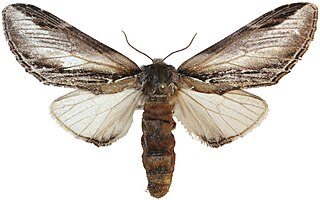
Pheosia tremula, the swallow prominent, is a moth from the family Notodontidae. The species was first described by Carl Alexander Clerck in 1759.

Seirarctia is a monotypic moth genus in the subfamily Arctiinae erected by Alpheus Spring Packard in 1864. Its single species, Seirarctia echo, the echo moth, was first described by James Edward Smith in 1797. It is found in North America, where it has been recorded from Georgia, Florida, Alabama and Mississippi. The habitat consists of thickets, scrubwoods and open areas.

Lophocampa argentata, the silver-spotted tiger moth, is a species of moth in the family Erebidae. It was described by Packard in 1864. It is found from British Columbia to southern California, and east to Arizona, Nevada, New Mexico, Colorado, Utah, Wyoming and possibly to northern Mexico.

Anarta nigrolunata is a moth in the family Noctuidae first described by Alpheus Spring Packard in 1867. It is found in the Arctic and alpine regions of the United States and Canada.

Schinia villosa, the little dark gem, is a moth of the family Noctuidae. The species was first described by Augustus Radcliffe Grote in 1864. In North America, it is mostly a western mountain species, however it has also been found across the plains eastward across Alberta and Saskatchewan to southern Manitoba. To the west it is found up to the coast ranges of Washington and British Columbia, south to Arizona.
Hypocoena rufostrigata is a species of moth of the family Noctuidae first described by Alpheus Spring Packard in 1867. It is found along the Atlantic coast of North America north to the Northwest Territories and Alaska, south in the west to California and Utah.

Lophocampa maculata, the Yellow-spotted tussock moth, mottled tiger or spotted halisidota, is a moth of the family Erebidae and the tribe Arctiini, the tiger moths. The species was first described by Thaddeus William Harris in 1841. It is found across Canada, the western parts of the United States, south in the Appalachians to South Carolina and Kentucky. They are also found in Southeastern Alaska.
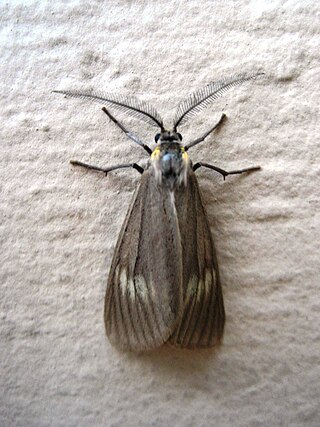
Phryganidia californica, the California oakworm or California oak moth, is a moth of the family Notodontidae. The species was first described by Alpheus Spring Packard in 1864. It is found along the coasts of the US states of California and Oregon.
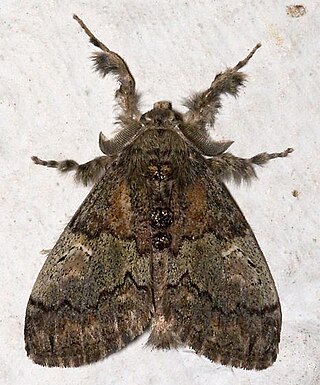
Dasychira basiflava, the yellow-based tussock, is a moth of the family Erebidae. The species was first described by Alpheus Spring Packard in 1865. It is found in North America from Massachusetts and southern Ontario west to Iowa, Texas, south to South Carolina and possibly Florida. It is also found in Southeastern Alaska.

Pheosia is a genus of moths of the family Notodontidae.

Misogada is a monotypic moth genus of the family Notodontidae erected by Francis Walker in 1865. Its only species, Misogada unicolor, the drab prominent, was first described by Alpheus Spring Packard in 1864. It is found in North America from Nova Scotia to Florida, west to Texas and north to Saskatchewan.
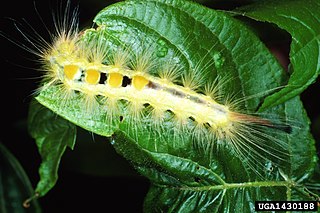
Orgyia definita, the definite tussock moth or definite-marked tussock moth, is a moth of the family Erebidae. It was first described by Alpheus Spring Packard in 1865. The species is found in eastern North America from Minnesota to New Brunswick and south to South Carolina, Mississippi, and Louisiana.

Digrammia subminiata, the vermillion granite or dark-waved angle, is a moth of the family Geometridae. The species was first described by Alpheus Spring Packard in 1873. It is found in western North America from British Columbia to Manitoba, south through Colorado to Arizona and California.
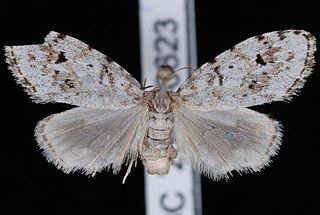
Clemensia albata, the little white lichen moth, is a moth of the family Erebidae. It was described by Alpheus Spring Packard in 1864. It is found in eastern North America, west across boreal Canada to south-eastern British Columbia. The range extends along the Pacific Coast south to Monterey Bay in west-central California. The habitat consists of moist forests, including coastal rainforests, oak woodlands and mixed hardwood forests.

Pseudohemihyalea edwardsii, or Edwards' glassy-wing, is a moth in the family Erebidae. It was described by Alpheus Spring Packard in 1864. It is found in the United States from western Oregon and the Columbia Gorge in southern Washington south to California, in the south-west east to western New Mexico. The habitat consists of oak woodlands and mixed hardwood forests at low elevations.

Spilosoma vestalis, the Vestal tiger-moth, is a moth in the family Erebidae. It was described by Alpheus Spring Packard in 1864. It is found along the coast of western North America, from California north to the Kitsap Peninsula in Washington and western Idaho.

















